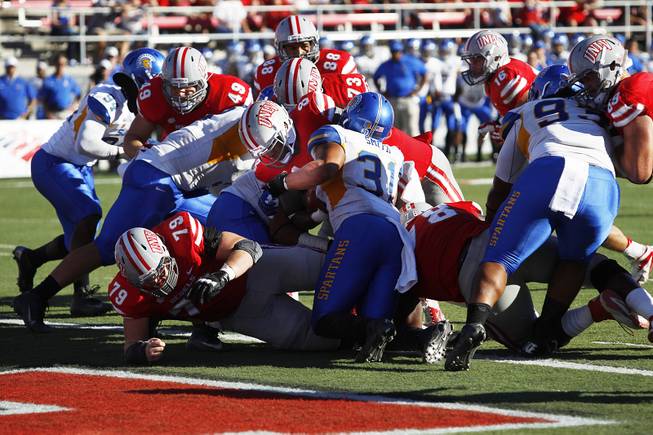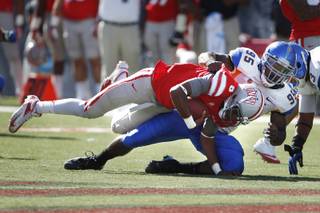
Sam Morris / Las Vegas Sun
UNLV quarterback Caleb Herring goes into the end zone for a 1-yard touchdown against San Jose State on Saturday, Nov. 2, 2013, at Sam Boyd Stadium. San Jose State won 34-24.
Monday, Nov. 4, 2013 | 12:26 a.m.
Related Content
- Rebels blame themselves for blown opportunities in loss to San Jose State
- Instant Analysis: Rebels show promise with strong third quarter, deserve credit for making game interesting
- Points a plenty expected in UNLV football’s homecoming matchup vs. SJSU
- It’s official: UNLV senior football players first to paint Fremont Cannon red
- By the numbers: Another streak ends in Rebels’ exciting 2013 season
- ‘We got the cannon’: Rebels take back rivalry trophy from UNR
- All UNLV football coverage
I’ve never been in UNLV’s locker room at halftime, so I don’t know exactly what the Rebels say and do during that time. What I do know is that what they accomplish after those breaks has defined their season.
Even though they came up short Saturday against San Jose State, the Rebels (5-4, 3-2) made it a game and gave themselves a chance to win because they completely flipped the script from the first half to the second. In this particular case, a lot of that had to do with the Spartans playing with a large lead and quarterback David Fales’ game-long struggles, but this wasn’t an aberration from UNLV.
I’ve previously looked into the Rebels’ stark contrast between the first and second halves. Now there is even more evidence to break down, and it seemed an appropriate time to revisit. If the Rebels are going to win again and reach bowl eligibility, recent history tells us they will do so thanks to an impressive second-half performance.
First, let’s dispel any idea of thematic halftime speeches like this or this. Like I said, I’m not actually in that room so I don’t know exactly how it plays out, but common sense and coach Bobby Hauck tell me this isn’t how it goes.
“All that Knute Rockne crap is overrated,” Hauck said.
Hauck made that comment after UNLV’s 31-21 victory against Central Michigan. After falling behind 21-0, the Rebels scored a touchdown right before halftime. When they came back out, they dominated the rest of the way, securing their first victory of the season and giving us a glimpse of what to expect the rest of this season.
In four of UNLV’s five victories, it trailed or was tied at halftime, and on Saturday it trailed San Jose State by 21 before making it a game in the fourth quarter. Because of this, it’s generally accepted that UNLV plays better in the last 30 minutes than the first, but I wanted to see exactly how great that disparity has been.
To look at this, I tossed out the four games with double-digit betting lines — at Minnesota, vs. Arizona, vs. Western Illinois and at Fresno State — because one team was clearly better than the other. UNLV’s success this year comes from the ability to win, or at least stay close in, games where that case is debatable. The Rebels aren’t world-beaters; they’re just making adjustments to win games that would have previously escaped them.
In the other five games — victories against Central Michigan, New Mexico, Hawaii and UNR plus Saturday’s loss to San Jose State — UNLV has been outscored by 41 in the first half and then outscored its opponent by 62 the rest of the way. The offense has been able to do that in part by executing on third down: The Rebels convert 28.6 percent of third downs in the first half and 50 percent in the second half.
Tied into that is time of possession. Only once in those five games did UNLV hold the ball more than its opponent in the first half, but the Rebels controlled it more in all of the second halves.
Defensively, the Rebels have forced seven more second-half punts than in the first half, and their second-half turnover margin is plus-3 compared with even in the first half. Because of a combination of UNLV’s defensive improvement and a shorter time of possession, the Rebels’ five opponents gained 38 fewer first downs in the second half compared with the first while UNLV gained 31 more.
Almost all the numbers support the general consensus: UNLV is a very good second-half team. Absent an Al Pacino-type speech, credit likely goes to the changes the Rebels implement at the break and the confidence they now have that things are only going to get better the longer the game goes.
There wasn’t much of this against San Jose State, but in the comeback victories defensive coordinator Tim Hauck has drawn up a variety of blitzes that surprise opponents and mask UNLV’s issues in the secondary. Offensively the Rebels aren’t usually changing things up as much as they’re wearing defenses down.
Senior running back Tim Cornett is mostly as strong late in games as he was early and the no-huddle attack is good at taking bites out of defenses until the whole cookie is gone. The Rebels rank fourth from the bottom in the country in passing yards per completion (9.98), and what that lacks in big-play potential it makes up for in longevity: body blows rather than a knockout punch.
That’s been good enough for five victories. One more and UNLV will equal its total from the past three seasons combined.
Some may focus on why UNLV isn’t able to play an entire game like it’s the second half. While that’s a fair question, it ignores how far the Rebels have come just to get to this point.
They aren’t a great team, but even if the Rebels trail at all three remaining halftimes, they will come out of the locker room believing they can win. Numerical evidence, not some speech, gives them that confidence.
Taylor Bern can be reached at 948-7844 or [email protected]. Follow Taylor on Twitter at twitter.com/taylorbern.


Join the Discussion:
Check this out for a full explanation of our conversion to the LiveFyre commenting system and instructions on how to sign up for an account.
Full comments policy